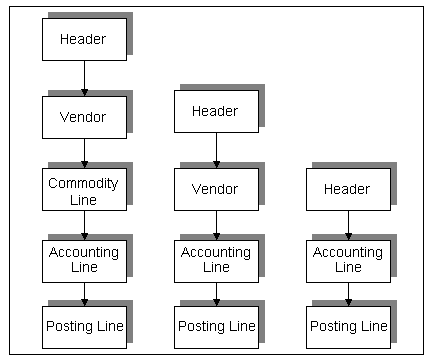
The CGI Advantage document model is a hierarchy of related data components that are processed and accepted together. It is the foundation for processing documents in the system. A document is generally used to capture data from a form and the document components represent the various sections of the form. An example of a document is a Payment Request- Commodity Based (PRC). It consists of the following main sections: Header, Vendor, Commodity, Accounting, and Posting Line. The document model is the hierarchical structure of these document components. The basic document model consists of a document Header and one or more document components (sections). The figure below illustrates the common models within the CGI Advantage Financial application, although, several variations exist.
Typical Document Models

Note that in the figure above, the Vendor, Commodity Line, Accounting Line, and Posting Line document components are the basic building blocks in the document models. In Advantage documents, not all of these components are required (for example, you can use none, some, or all of the components) and other components in addition to those shown can exist anywhere in the model. Each Document Type (for example, PO (purchase order), PR (payment request)) defines which document components are included in the document hierarchy. If you use any of the above components, they follow this fundamental hierarchy: Header-Vendor-Commodity-Accounting-Posting.
The document model supports a one-to-many relationship between components as the hierarchy moves downward. Often referred to as a parent – child relationship, the parent (for example, commodity line) can have many children (for example, accounting lines). However, a child (for example, commodity line) can have only one parent (for example, vendor).
A description of the basic components follows:
Header - Specifies general information that relates to the overall document or form. The fields that are presented on the Document Catalog (for example, Document ID, User, Date) are included on the document Header. Other examples of information contained on the Header include Document Description and Document Amount.
Vendor/Customer - Specifies vendor and/or customer information associated with the document. In some cases, multiple vendors or customers are associated with a single document. For example, the Cash Receipt (CR) document records groups of payments received and processed periodically throughout the day from several customers. In other cases, such as when purchasing goods from a vendor, only a single vendor is associated with the Purchase Order (PO) document.
Commodity Line - Specifies information associated with the purchase of a single commodity. Multiple commodity lines are allowed on a document.
Accounting Line - Specifies an individual account to be charged or to receive funds. Accounting lines are included on all documents recording accounting events. As described above, there can be multiple accounting lines for each commodity line.
Posting Line - Specifies the related journal posting(s) for each accounting line. There can be multiple posting lines for a single accounting line. For more details about journal posting, see the Journals and Ledgers section of this chapter.